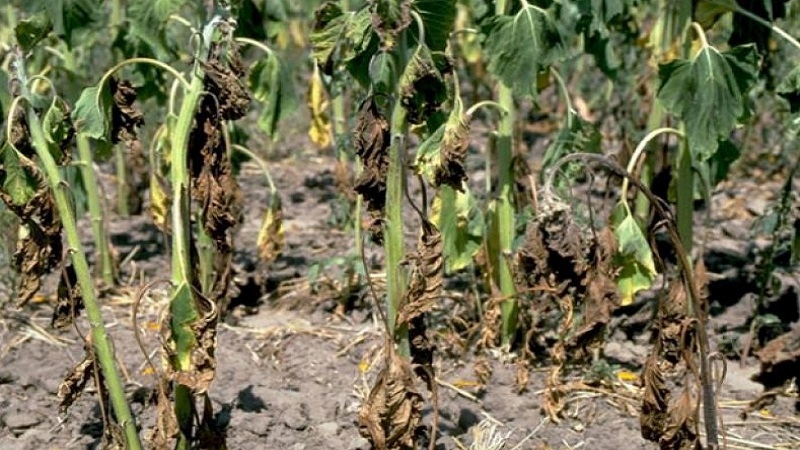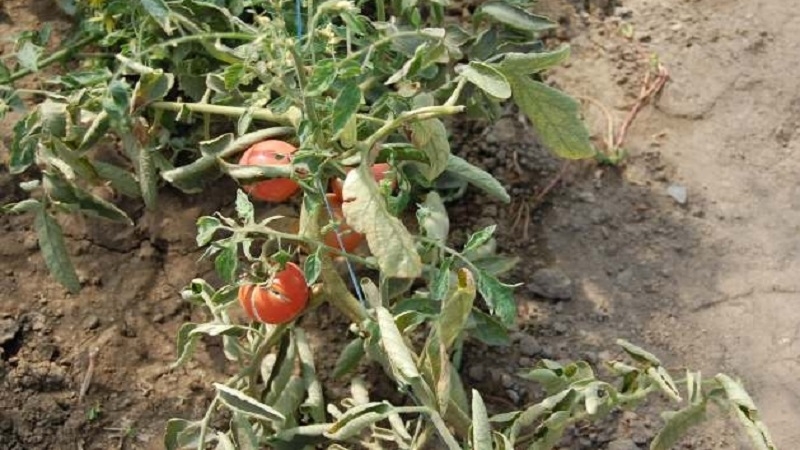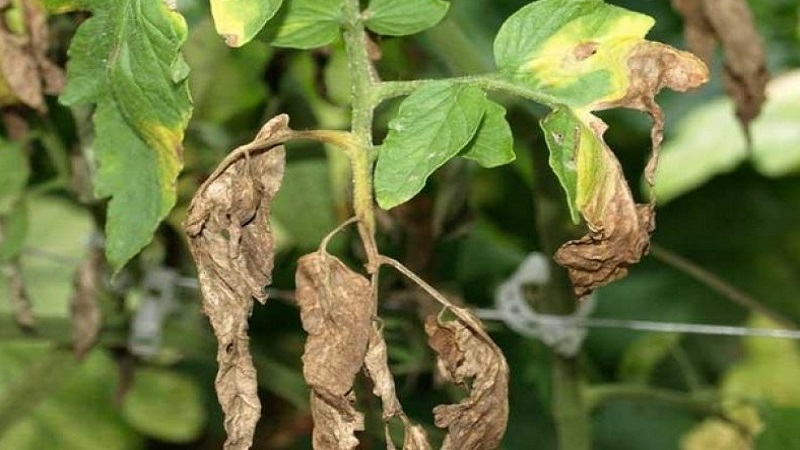The most effective methods for treating tomato fusarium wilt: instructions that even a beginner can handle
Do you want to get a rich harvest of tasty and juicy tomatoes? This can be done if all the conditions for growing crops are observed and preventive measures are not neglected. Do the leaves curl and the plant withers? This may be a sign of the development of fusarium. What is fusarium wilt of tomatoes, how to deal with it and what kind of prevention to carry out - you will learn all this from our article with photographs of the manifestation of the disease in nightshades.
The content of the article
What is this disease
Fusarium is a dangerous fungal disease of tomatoes, resistant to chemicals... Its spread indicates errors in plant cultivation. You can meet the disease both in greenhouses and in the open field in all climatic regions. From the beginning of the development of the disease until the complete death of the plant, it can take 2-3 weeks.
How does it affect tomatoes
The fungus affects the vascular system of the seedlings, as a result of which the roots and fruits begin to rot, and the plant itself begins to dry out. The photo shows that the disease is spreading from the bottom up. The fungus can be in the soil, it enters the plant through damaged or small roots. As the disease progresses, rot appears on the root system, and fungi through the vessels penetrate the stem and leaves.
The first sign of fusarium seedling wilting is the dropping of the lower leaves. However, this symptom is typical for many other ailments. Fusarium is accompanied by discoloration of petioles and foliage curling.
Experienced gardeners have noticed that most often the disease affects plants grown in greenhouse conditions. However, if all conditions for tomato growth (temperature, humidity, lighting) are met, it can be avoided. Fusarium wilting is also typical for seedlings grown from year to year in the same place.
Description of symptoms and external signs
It is very difficult to recognize fusarium in time, since its symptoms are similar to the manifestations of other diseases or soil depletion. Novice gardeners, not understanding the true reason for the drying out of tomatoes, begin to use various fertilizers that have no effect and can harm the plant.
Manifestations:
- pale green or yellow leaves;
- discoloration of the veins along which the plant sap moves;
- deformation of leaf petioles;
- curling foliage;
- falling of the lower leaves;
- gradual wilting of the plant;
- the formation of white bloom on the roots at high humidity.
At first, the lower leaves turn yellow and fall, then the upper part of the green mass begins to change color, dry and deform. The disease can be recognized by cutting the stem - the vessels acquire a brown color. If the infected plant is kept in a room with high humidity for several days, then white mycelium of the fungus will be visible.
Feature... The disease can only be recognized during flowering or fertilization of plants. During this period, the main phase of wilting occurs.
Reasons for the appearance and infection
Fusarium is a fungal disease that not only parasitizes the plant, but also causes it to dry out. To select the correct treatment, you need to understand the nature of the pathogen and determine the conditions for its spread.
Causative agent of the disease
The causative agent is fungi of the genus Fusarium, living in the soil at a depth of 10 cm... Once inside the plant, they affect its vascular system, in particular the veins through which the juices circulate.
Fungi, multiplying, completely clog these channels, which disrupts the nutrition of the green mass of the seedlings. Since the causative agent of the disease is inside the plant, it is very difficult to completely eliminate it without harming the tomato.
Microorganisms release compounds that negatively affect the condition of the leaves. As a result, they begin to curl and then fall off.
Important! The causative agent of the disease is resistant to various chemicals, so it is very difficult to cope with it.
The fungus can remain in the soil and plant debris for a very long time, which can lead to infection of new crops.
Terms of distribution
The pathogen can be found in the substrate, in garden tools, in seeds and soil. Pathogenic fungi do not interfere with the development of seedlings until conditions favorable for their spread are established.
Symptoms of the disease begin to manifest themselves clearly during the period when there are changes in air temperature: hot days are replaced by cold nights. If the temperature drops to 16 ° C, the plants will begin to die rapidly. An increase in humidity contributes to the active reproduction of fungi that infect plant stems and leaves.
Low soil nutrient content and mistakes in plant care can spread the disease. Growing seedlings in one place also creates favorable conditions for the growth of fungi.
Factors predisposing to fusarium:
- thickening of the beds;
- overuse of chemicals;
- non-compliance with crop rotation;
- finding a site in a place with a close occurrence of groundwater;
- shortening daylight hours;
- poor lighting in the greenhouse;
- drought, drying out of plant roots;
- close location to the vegetable garden of industrial zones.
Distribution methods:
- Through seeds - when the seed is infected, the plant begins to dry out even during the period of fruit formation.
- Through the roots - fungi in the soil are introduced into the plant through damage to the root system.
Attention! The pathogen can enter tomatoes through minor damage caused during pinching or transplanting.
How and what to treat
Fusarium is a disease that must be treated. If inactive, all plants can die. However, since the causative agent of the disease is resistant to chemicals, it is very difficult to cure tomatoes.
Important! There is no point in treating severely damaged tomatoes - they are uprooted and burned.
Chemicals
Anti-fusarium drugs are chemical and biological. Biological do not contain chemical components, they are bacteria that can neutralize pathogenic fungi. Such funds are considered quite effective, as they saturate the soil with beneficial microorganisms, which reduces the likelihood of the appearance of dangerous bacteria.
At the first signs of the development of fusarium wilting, the biological preparation "Trichodermin" is effective. For one bush of an adult plant, 0.5 l of solution is enough, the drug is poured under the root. Also, this tool is suitable for preventive soil cultivation before planting seedlings: 1 kg of funds per 10 sq. m.
Biological agents for fighting the disease also include Trichocin, Alirin-B, Gamair. For irrigation of diseased plants, Planriz and Pseudobacterin-2 are suitable. One bush consumes 100 ml of solution.
Chemical preparations are more effective than biological ones, but they have a significant drawback: after processing, you cannot eat fruits from a diseased plant for several weeks. Experts recommend processing at least three weeks before harvest.
You can spray the affected leaves of the plant with the Falcon preparation - 1 mg of the agent will be needed for 3.3 liters of water.The procedure is carried out using a finely dispersed spray gun, treating the stem and leaves from both sides. The drugs "Previkur", "Strekar", "Benazol" and "Fundazol" also showed themselves well in the treatment of fusarium.
Traditional methods
Practice has shown that it is possible to stop the development of fusarium wilting without the use of special preparations. To make the fruits as environmentally friendly and safe as possible, you can use dolomite flour or lime. Funds are abundantly laid out in the beds.
For watering and spraying, you can use a manganese solution or preparations containing copper.
Agrotechnical techniques
Compliance with the rules of crop rotation allows you to avoid many diseases. They involve regularly changing the plot for growing tomatoes. Tomatoes can be planted in their original place only after 3-4 seasons. Cabbage, pumpkin, and cucumber are good precursors for nightshades. But it is better not to plant tomatoes in place of eggplants, peppers, potatoes and physalis.
If the gardener does not have the opportunity to plant seedlings in another place, and the disease has already manifested itself earlier, then when buying seeds it is worth choosing varieties that are resistant to the fungus.
These include:
- De Barao;
- Blitz;
- Orko F1;
- Raisa;
 Pink giant;
Pink giant;- Monica;
- Rusich;
- Rhapsody;
- Sun;
- Sorento;
- Plot;
- Senzafin F1;
- Swallow;
- Charisma F1;
- Carlson;
- Spartak F1;
- Miron F1;
- Vologda F1;
- Ural F1.
Moderate use of top dressing will also promote healthy plant growth. Before planting seedlings, it is recommended to abundantly fertilize the soil using natural ingredients: compost or manure. If the gardener does not have the opportunity to feed with organic substances, then nitrogen-containing preparations can be used.
Preventive measures
It is impossible to completely get rid of Fusarium blight; its pathogen may still remain in the vascular system of the plant. Planting disease-resistant tomatoes does not guarantee protection against fungal growth.
Prevention:
- cleaning the site from plant residues after harvesting;
- preparation of land for planting seeds: digging, disinfection, loosening;
- disinfection of seed material: heating or treatment with fungicides;
- regular ventilation of the greenhouse;
- providing additional lighting;
- disinfection of garden tools and garter material;
- mulching the beds;
- holding pinching using a secateurs;
- regular hilling of seedlings.

Gardener tips
The disease mainly affects plants grown in the greenhouse. You can reduce the risk of illness by regularly ventilating the area after an evening watering. It will be useful to equip it with a good ventilation system.
Pre-planting seed treatment is the key to plant health. The material must be treated with drugs belonging to the benzimidazole group, for example, Fundazole or Benazole. Disinfection is carried out two weeks before planting, for 1 kg of seeds, 5-6 g of the product will be needed. The drug is dissolved in water, after which the solution is poured into a spray bottle. Seeds placed in a container are sprayed and mixed. After 20-30 minutes after the procedure, the material is scattered to dry, and then laid out in bags.
According to summer residents, the development of the disease can be avoided by additional processing of the roots. The root system of the seedlings is dipped in a fungicide solution for a few seconds, after which they need to be dried a little and planted on the garden bed.
Preplant soil treatment is also capable of protecting against fusarium wilting. For disinfection, you can use copper sulfate: 70 g of the product is dissolved in one bucket of water. Dolomite flour or chalk will also help neutralize fungi.
It has been observed that pathogenic fungi respond poorly to mulching.Most summer residents use straw for these purposes, but you can also try to put black film on the beds - the material inhibits pathogens.
After harvesting, the gardener needs to clear the area of vegetation and decontaminate the soil. For these purposes, lime, a solution of potassium permanganate or a mixture of ash and powdered sulfur are used.
Conclusion
Fusarium desiccation is a common tomato disease. It must be taken seriously: the disease can destroy the entire crop in a few weeks. It is useless to treat severely damaged plants - they need to be burned to stop the spread of the fungus.
At the first signs of fusarium, chemical or biological preparations can be used; folk methods also have medicinal properties. Compliance with simple preventive measures is the best protection against this dangerous disease.